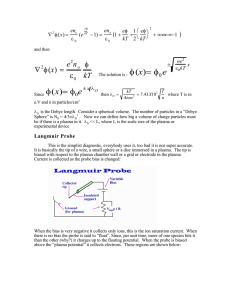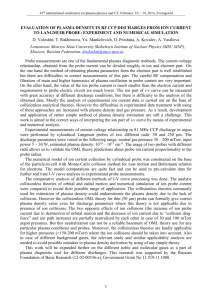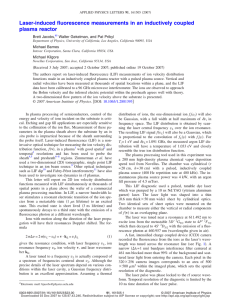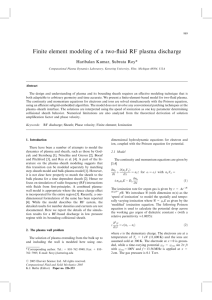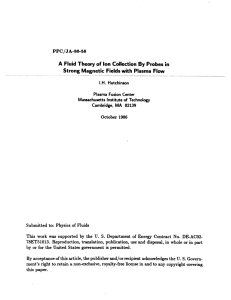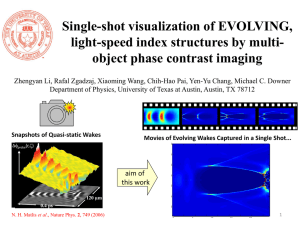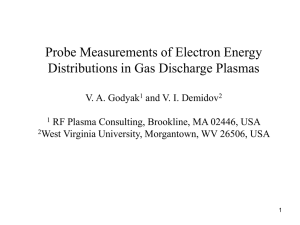PPT - DOE Plasma Science Center
advertisement
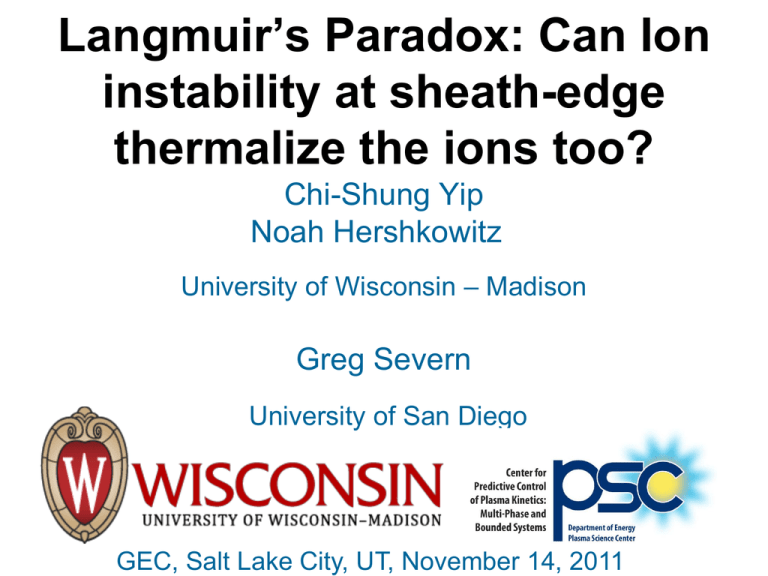
Langmuir’s Paradox: Can Ion instability at sheath-edge thermalize the ions too? Chi-Shung Yip Noah Hershkowitz University of Wisconsin – Madison Greg Severn University of San Diego 1 GEC, Salt Lake City, UT, November 14, 2011 Pre-sheath and charge exchange explained • Ions travel through a potential drop into the sheath boundary to accelerate to Bohm’s velocity. • The potential drop affects only charge particles • Neutral atoms are not charged • If charge exchange occurs, ions will be born from a zero drift velocity Maxwellian of the neutral gas. Pre-sheath 2 Langmuir’s Paradox • As old as plasma physics itself! • Originally found by Langmuir. • Energetic electrons on the tail of the Maxwellian distribution of a plasma are not confined by the plasma potential. • Notice that in his experiment, ionization mostly comes from electrons on the tail of the Maxwellian, so his plasma should not have existed. • However Langmuir found that electrons are Maxwellian up to 50eV (with his Langmuir probe), so there must be an additional mechanism in electron thermalization. 3 4 Most electrons on this side should be lost 5 But what is this mechanism? • In Langmuir’s experiment, the electron-electron scattering collision length is far greater than the tube diameter, so electron-electron scattering without additional assumptions does not explain the phenomena. • Various explanations have been proposed: sheath scattering, photons scattering, sheath oscillations, etc. • None of them gives a satisfactory answer to the paradox. 6 The Baalrud theory • Baalrud et al. resolved the Langmuir’s Paradox in the following way[1]: • Ion Acoustic Instability in the presheath, increases the electron-electron and ion-ion collisional cross section of an otherwise stable plasma by 100 times • This quickly thermalizes electrons near the sheathedge. replenishing high energy electrons lost due to insufficient sheath potential. • MHz instabilities near sheaths has been observed by previous researchers. [2] [1] S. D. Baalrud and C. C. Hegna, “Kinetic Theory of the Presheath and the Bohm Criterion,” Plasma Sources Science and Technology [2] D. Gabor, E. A. Ash, and D. Dracott, Nature 176, 916 (1955). 7 A “two stage” ion velocity distribution phenomenon is found in previous experiments • Claire et al. measured ion velocity distribution functions (ivdfs) throughout the pre-sheath. • Plasma created in a 80 cm long x 40 cm diam. filament discharge device. • Neutral pressure 1.8 x 10-4 mbar (0.135 mTorr) • Te = 2.5eV, ne ~ 6x109cm3 • Non-Maxwellian tails of ivdfs are seen as ions enters pre-sheath, and thermalizes as they goes into sheath edge Claire N, Bachet G, Stroth U and Doveil F 2006 Phys. Plasmas 13 062103 8 Severn et al., 2003 G. D. Severn, X. Wang, E. Ko, and N. Hershkowitz, Phys. Rev. Lett. 90, 145001 (2003). 9 This is also resolved by the Baalrud theory • The Baalrud theory explains the “two stage pre-sheath with the following: • Ions entering the beginning of the presheath will first become non-Maxwellian due to charge exchange • As ions travel towards the sheath edge, they will thermalize into a Maxwellian distribution due to ion acoustic instability enhanced friction. 10 Experimental Approach • Pre-sheath lengths are proportional to the ion neutral collision length which is inversely proportional to neutral pressure • According to Baalrud et al. ion acoustic instability will not have adequate distance to grow as pre-sheath shortens. • Experiments were set up to measure ivdfs throughout presheaths to verify previous findings. • Control experiments at higher pressures were setup to find the existence of a threshold pressure where this phenomena cease occuring. 11 Experimental Setup • Plasma is produced in a multi-dipole device by energetic electrons emitted from heated filaments. • Electron temperature is measured with a Langmuir probe. • Laser Induced Fluorescence determines ion flow velocities and ion temperatures. Xe+ LIF is employed • An emissive probe measures the plasma potential profile near a negatively biased plate [3] • The sheath/presheath boundary is identified from the slope change of the emission current vs bias voltage curve [3] Wang X, Hershkowitz N. Simple way to determine thee edge of an electro-free sheath with an emissive probe, REVIEW OF SCIENTIFIC INSTRUMENTS 77, 4, 043507. 200612 Multi-dipole device P M T Magnets -60 V, 1.0A e 60 cm LIF e Hot Filament e Electrode Plate -30 V Langmuir Probe Z Emissive Probe Probe Circuit Laser Beam Dump Pump 70 cm 13 Experimental setup of the laser system Periscope Chopper Controller Wavelength Meter Power Meter Mirror I2 Cell To Chamber Mirror Laser Driver Optical Chopper Laser Head I2 Cell Heater Heating Ribbon 14 Multi-dipole Device PMT Ar LIF Laser EP - Argon + Xenon - Gas pressure: 0.1 ~ 1.0 mTorr - Filament bias: -60 V - Emission current: 1.0 ~ 1.25 A - Electron density: ~ 109 cm-3 - Electron temperature: ~ 1 eV - Using the filament of the emissive probe as an aiming point of the laser. 15 How does the LIF work? Optical excitation of Xe metastable ion in state 5d4F7/2 to 6p4D5/2 with the laser of 680.574 nm Relaxation from the state 6p4D5/2 to 6s4P3/2. Observe the fluorescence at 492.15 nm It is assumed that the metastable ions are in thermal equilibrium with ground state ions 16 The sheath edge is determined from the change in slope of inflection point vs Vp Plasma parameters - Ar 0.7 mTorr - Filament: -60 V, 1.00 A - Electrode: -30 V d 2 0 2 e(ni ne ) dx Where is the sheath edge? - Emitted electrons from the probe reduces the curvature of potential. - The reduction in the curvature of the potential increases as the emission increases. - The inflection point becomes more positive with the increased emission in a sheath. - An electron-free sheath is identified as the position where the inflection point changes from increasing with emission to decreasing with emission. - From the figure, the sheath edge is determined to be 0.35 ~ 0.40 cm For more information about emissive probe techniques, please attend JP Sheehan’s presentation on Wednesday-Abstract: LW3.00001 : “A Comparison of Emissive Probe 17 Techniques for Electric Potential Measurements in a Complex Plasma” 2:00 PM–2:15 PM Maxwell’s Demon is used to control plasma temperature 0.025mm Tungsten wires nicely lined up 18 At higher pressure charge exchange tail persists 19 At low pressure, Claire et al.’s phenomenon are replicated 20 Summary • Preliminary data recreated phenomenon by Claire et al. • A higher pressure case where ion acoustic instability no longer thermalize non-Maxwellian tails of ivdfs, seems to be found. This is consistent with Baalrud’s predictions. • Further LIF experiments will be performed at additional pressures to obtain complete spectrum of change in the phenomena. 21 This work was supported by U.S. Department of Energy Grants No. DE-FG02-97ER54437 and No. DE FG02- 03ER54728, National Science Foundation Grants No. CBET0903832, and No. CBET-0903783 22
